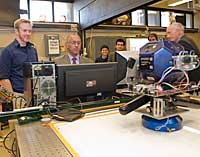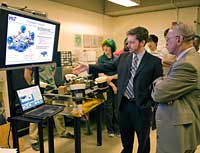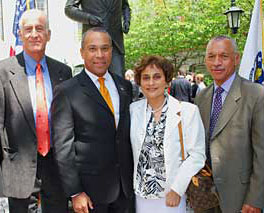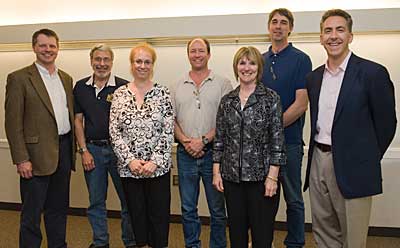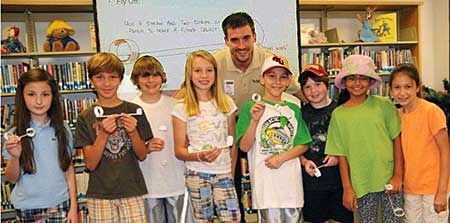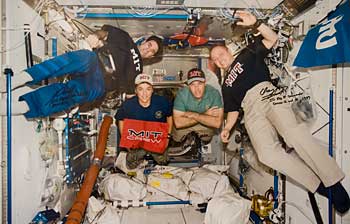
MAY 2010In this issue: |
|||
1. New AeroAstro degree program approvedOn April 22, MIT faculty voted to approve AeroAstro's new engineering degree program. Launching this September, the 16-ENG program leads to the degree Bachelor of Science in Engineering as recommended by the Department of Aeronautics and Astronautics. Undergrads who pursue this flexible degree will receive a more interdisciplinary engineering education, developing a deeper level of understanding and skill in a field of engineering relevant to multiple disciplinary areas, or a greater understanding and skill in an interdisciplinary area. Concentrations include computational engineering, energy, environment, engineering management, robotics and control, and space exploration; other concentration areas are anticipated in the near future. These concentrations draw on subject offerings from across the Institute. The rigorous degree path includes Unified Engineering and two second-level core subjects as a foundation, followed by a heavily technical six-subject concentration, capped off by AeroAstro’s multi-semester, hands-on laboratory and capstone Conceive-Design-Implement-Operation subject sequences. AeroAstro department head Professor Ian Waitz said, "The new degree is a great option for students who want to gain more depth in some of the multidisciplinary areas that are increasingly critical for aerospace.” According to AeroAstro associate head Professor David Darmofal, "Rising sophomores can pursue the 16-ENG degree, and juniors, too, since the core overlaps significantly with the 16-1 and 16-2 core." Those interested in learning more about it should contact Professors Brian Williams, Waitz, or Darmofal. More information will also be available shortly on the department Web site. |
|||
2. USNWR ranks AA #1Once again, AeroAstro rates at the top in US News and World Report's annual rankings. The department tied for first place with Cal Tech in graduate aerospace programs. It also ranked in first place for undergrad aerospace in schools offering a doctorate as the highest degree. Department head Ian Waitz suggests that while high rankings are satisfying, people shouldn't put too much stock in them. "The important thing is to focus on our strategy for excellence, bringing the very best students, faculty, and staff into our community and fostering an environment that enables them to do great things," Waitz said. |
|||
3. NASA admin visits AeroAstroDuring a May 10 MIT visit to deliver the annual Massachusetts Space Grant Consortium public lecture, NASA Administrator Charles F. Bolden Jr. spent some time in the Space Systems Lab where students spoke with him about several of the lab's projects including SPHERES microsatellites and the Terrestrial Artificial Lunar and Reduced Gravity Simulator robotic lander. Bolden was so impressed that he specifically mentioned SPHERES in a May 12 hearing before the Senate Committee on Commerce Science and Transportation.
(Left) NASA Administrator Bolden "flies" a SPHERE microsatellite under the direction of Brent Tweddle, and (right) learns about the TALARIS Google Lunar X-Prize contender from Phillip Cunio.While in the Bay State, Bolden visited the State House where he joined Governor Duval Patrick in announcing NASA's partnering with the AeroAstro-based Massachusetts Space Grant Consortium in the Summer of Innovation. The Massachusetts Space Grant Consortium will focus on providing information from NASA's robotics, Earth and space science, astrophysics, and engineering missions to nine Massachusetts educational institutions and industries that serve middle school students and teachers.
|
|||
|
4. 13 teams spar in Unified Flight CompProfessor Dave Darmofal reports that the 2010 Unified Flight Competition was held on May 12 with all 13 teams successfully completing flights. This objective of this year's competition was to design, build, and fly a radio-controlled aircraft, while maximizing the difference between the payload weight and the empty weight. The winning aircraft had a payload weight of 758 grams and an empty weight of 300 grams (gross take-off weight of 1058 grams). The winning teams were: First place — Michael Benitez, Sydney Giblin,Victoria Hammett, Christian Valledor; Second place — Ian Fischer, Shari Haynes, Philip Hunt, Pearle Lipinski; Third place — Shan Guruvadoo, Jordan Lopez, David Sternberg; Honorable mention — Adrian Bullock, Angelica Cardona, Mark Chodas, Nnaemeka Opara, Sarah Ferguson, Matthew Ferraro, Lionel Sotomayor, Vicky Thomas Steven Ojeda, Kristopher Weaver, Ezekiel Willett. Professor Jaime Peraire presented all with special certificates. A video of the competition appears in the AeroAstro Web Video Gallery. |
||
|
5. Alums celebrate launch abort systemA number of AeroAstro alums had a personal reason to celebrate NASA's successful May 6 test of the Orion Launch Abort System — they work on the LAS program for Orbital Sciences Corp., the company that's designing and building the important safety mechanism. Henri Fuhrmann (Course 16, '92) is the LAS program manager (and his son, Adam, is an AeroAstro junior). Chief engineer is R. Bryan Sullivan (MS Course 16, '85). Orbital Advanced Programs Group GM is Antonio Elias (BS, MS, PhD Course 16). Justin Fox (PhD Course 16 '07), was the Orbital representative on the thermal team deciding if the temperatures were within limits for launch. Thanks to Charlotte Pappageorge, (Course 16, '96) for providing this information. She's the LAS requirements, test, and verification lead. And, by the way, Orbital CEO is Dave Thompson (Course 16, '77). |
||
6. Students, staff, prof are feted at dinnerCongratulations to the following who were recognized at the May 5 AeroAstro Senior Awards Dinner. Well deserved, all!
|
|||
7. Annual department awards presentedAeroAstro held its annual Awards Lunch on May 27. Senior Administrative Assistant Carol Neimi was presented the Wings Award in recognition of her outstanding work keepinh the department running smoothly while maintaining a smile and caring attitude. The AeroAstro Spirit of XVI Team Award was presented to Todd Billings, Dick Perdichizzi, and Dave Robertson for their outstanding work to educate our students through helping hands, critical eyes, and encouraging words The Spirit of XVI Individual Award went to Liz Zotos for going above and beyond to assist students, offer advice, organize extra help, and share her wisdom as a member of the Man Vehicle Laboratory and the AeroAstro Department. The Vicki Kerrebrock award was given to Jeff Hoffman, who was travelling could not attend the lunch, for all he has done to inspire, connect, lead, mentor, and educate our students, staff, and faculty. From the big to the small, and everything in between, he has contributed significantly to a stronger sense of community in AeroAstro. Congratulations to all. For descriptions of the awards and more on the AeroAstro Awards and Recognition Program, visit the department Web site awards page. — Sue Whitehead |
|||
AeroAstro 2010 award recipents posing with Professors Dramofal (l) and Waitz (r) are Dick Perdichizzi, Liz Zotos, Todd Billings, Carol Niemi, and Dave Robertson. Professor Jeff Hoffman was also an award recipient. |
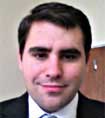
Steven Barret
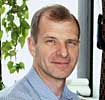
John Keesee
![]()
8. Comings and goings
Dr. Steven R. H. Barrett will join AeroAstro faculty June 1 as a Charles Stark Draper Assistant Professor. Barrett, whose primary research interest is aviation environmental impacts, will be associated with the department's Partnership for AiR Transportation Noise and Emissions Reduction research group and a member of the department's Vehicles Sector.
Col. John Keesee has left MIT to work as a civilian systems engineer for the US Air Force in Bedford. He will be back for this year's commencement and hopes to continue some connection with AeroAstro in the future.
![]()
9. Newsbriefs
Professor Annalisa Weigel discussed her "Survey of Aerospace Student Attitudes" as keynote speaker at the Science, Technology, Engineering, and Mathematics Joint Societies Capitol Hill Reception in April.
AeroAstro PhD candidate Paul Grogan was selected from more than 2,600 applicants to receive a 2010 National Defense Science and Engineering Graduate Fellowship. The Department of Defense awards these fellowships to people "who have demonstrated ability and special aptitude for advanced training in science and engineering."
Artifical gravity work by Justin Kaderka and Professor Larry Young is featured in the recent Space.com article "New Artificial Gravity Tests in Space Could Help Astronauts."
Several new appointments for Professor Dava Newman: she's been appointed to the NASA Advisory Council's Committee on Technology and Innovation where she will provide advice to NASA and help shape the agency's new direction; and she's accepted a position on the International Advisory Board of the Politecnico de Torino where she'll offer advice primarily on their new Human Space Robotics initiative.
AeroAstro seniors Jennifer L. Allen, Isaac M. Asher, Kevin S. Lim, and Eric Timmons have been elected to the MIT Phi Beta Kappa chapter. A faculty committee conducts the election, reviewing the students' academic records to identify those with superlative records and clear evidence of breadth in the liberal arts.
The MIT Undergraduate Research Opportunities Program presented Professor Paulo Lozano with its 2010 Outstanding UROP Faculty Mentor Award. The award is presented to mentors who have demonstrated exceptional guidance and teaching in a research setting.
62x alums Jonathan Brent Parham and Matt Fitzgerald captured first place in the NE Regional ASEE student conference award for their paper and presentation, "Flow Control for Boundary Layer Ingestion in an S-duct Diffuser." Their advisor was AeroAstro research engineer Elena de la Rosa Blanco.
Grad student Fabio Fachin was awarded the Whitaker Health Sciences & Technology Fellowship for next year by MIT Office of the Dean for Graduate Education. Professor Brian Wardle says, "Fabio's credentials — he is a Fulbright scholar — as well as the compelling nature of his bioNEMS work likely helped him win."
Professor Dave Miller reports that the SPHERES facility on the International Space Station (developed by SSL, AFS, the AA Department '99-'00 16.83x Capstone Class, and the CDIO program) is transitioning to ISS National Laboratory status. The ISS National Laboratory is designed by NASA to promote increased ISS use to promote science, technology, engineering, mathematics, exploration, and economic development of space.
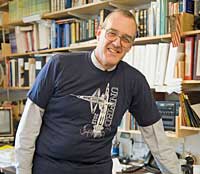 |
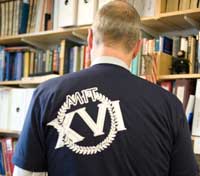 |
Professor Paul Lagace models the 2010 Unified Engineering t-shirt. Student Yukiko Shimizu's design features a plane and rocket on the front and the XVI "stamp of approval" on the reverse. A department tradition of recent years, shirts were distributed this month.
Grad student Brandon Suarez did his part to encourage young people to consider careers in engineering when he took several AeroAstro display panels to his alma mater, Berkeley Prep Elementary School in Tampa, Florida. Under Brandon's guidance, the children made circular-wing gliders. Brandon reports that the kids had a great time, and maybe we'll see some of them here in another 10 years or so.
Students display the gliders they made under Brandon Suarez's guidance.
10. Astroalum signed photo donated
Bryan McKay, president of One Giant Leap, has presented a delightful gift to the department: a large photo of four MIT alumni astronauts together aboard the International Space Station. Pictured wearing MIT-emblazoned attire are Heide Stefansyion Piper, Steve Bowen, Greg Chamitoff, and Mike Finke. And, each has signed the photo.
One Giant Leap Inc is a nonprofit organization, founded by McKay, that promotes space exploration, math and science in communities and public schools, sometimes by arranging visits to the schools by astronauts. "I have found that the astronauts who went to MIT really like to come back to Boston and MIT and they are proud that they went to school there," McKay says.
The photo is on display in a wall case in the Building 33 second floor hallway.
From November 16-28, 2008, MIT alum-stronauts (from left) Greg Chamitoff, Heide Stefansyion Piper, Steve Bowen, and Mike Finke were together on the International Space Station. |
 V-22 hovers over campus May 3
V-22 hovers over campus May 3
11. Fly-ins are MIT tradition
Many Aero-Astroers enjoyed the spectacular May 23 V-22 Osprey fly-in, orchestrated by the MIT Flying Club. Interestingly, there is a long tradition of aircraft fly-ins at MIT. One such example took place around 1931-32 when an autogyro landed where Kresge Oval and the Chapel are today. The photo, which is from MIT Museum collection, is marked only "Coca-Cola Gyro." However, a little research reveals that sometime around 1931-32, Coca-Cola obtained a Pitcairn PCA-2 autogyro and used it for promotional purposes. No doubt, that was the machine that visited the MIT campus.
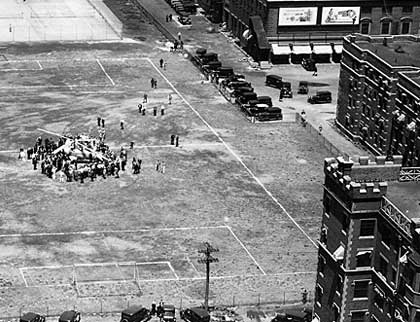
MITers surround a Pitcairn autogyro sometime in the early '30s. The MIT Chapel is in this spot today. (MIT Museum) |
MITweets from AeroAstro
Don't wait for your enews and emails — keep up with AeroAstro news as it happens — follow the department on Twitter.
